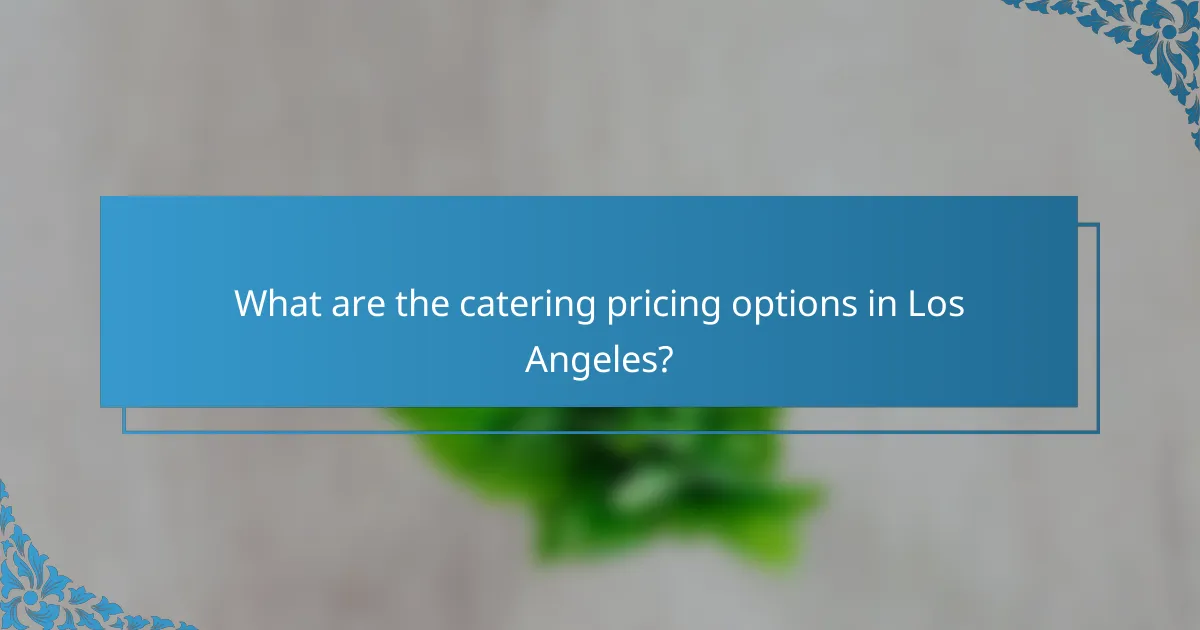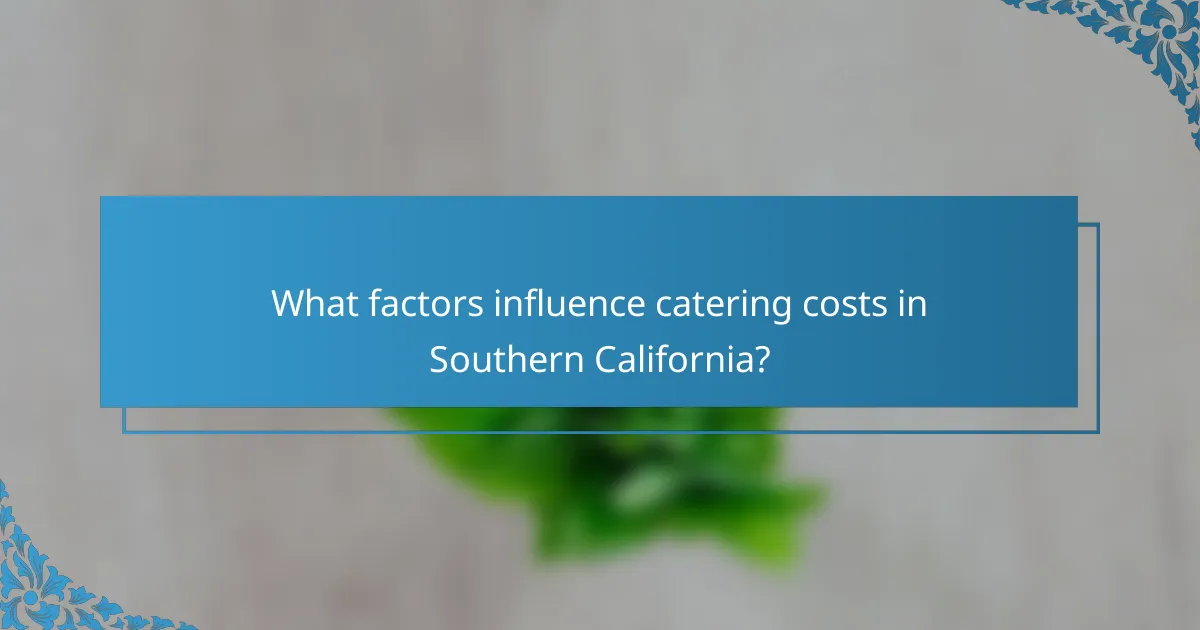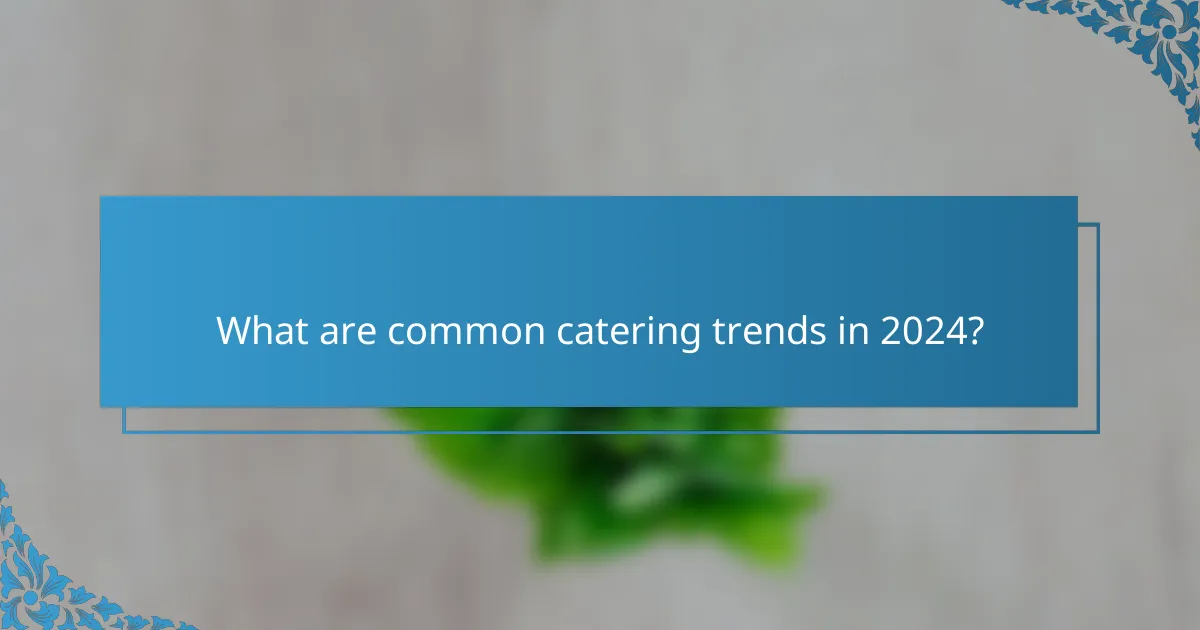When planning an event, catering pricing can significantly impact your budget, with costs influenced by service type, menu choices, and guest count. Customizing your menu not only allows for personalization but also ensures that dietary needs and preferences are met. Additionally, being aware of service fees, including gratuity and delivery charges, is essential for avoiding unexpected expenses and ensuring a smooth event experience.

What are the catering pricing options in Los Angeles?
Catering pricing options in Los Angeles vary widely based on the type of service, menu selection, and event size. Understanding these options can help you budget effectively and choose the best fit for your event needs.
Per-person pricing
Per-person pricing is a common structure for catering in Los Angeles, where costs typically range from $20 to $150 per guest, depending on the menu complexity and service level. This model allows for straightforward budgeting, as you can easily calculate total costs based on your guest count.
When considering per-person pricing, be aware of what is included in the cost. Some caterers may offer a basic package, while others might include additional services like setup, cleanup, and staff. Always clarify these details before finalizing your decision.
Package deals
Package deals are another popular option, often providing a set menu and services at a discounted rate. These packages can range from $30 to $100 per person and may include appetizers, main courses, desserts, and beverages.
Choosing a package deal can simplify planning, as it typically covers all essential elements of your catering needs. However, ensure that the menu aligns with your preferences and dietary requirements, as customization options may be limited.
Hourly rates
Hourly rates are primarily associated with staffing and service for events, with costs generally falling between $25 and $50 per hour per staff member. This pricing model is useful for events where you need additional help for a specific duration, such as setup, serving, and cleanup.
When hiring staff on an hourly basis, consider the total number of hours needed and the complexity of your event. It’s advisable to discuss your requirements with the catering service to ensure adequate staffing levels and avoid unexpected costs.

How can I customize my catering menu?
Customizing your catering menu allows you to tailor food offerings to meet specific tastes, dietary needs, and event themes. This process typically involves selecting dishes, accommodating dietary restrictions, and incorporating seasonal ingredients to enhance freshness and appeal.
Dietary restrictions
When customizing your catering menu, it’s essential to consider dietary restrictions of your guests. Common restrictions include vegetarian, vegan, gluten-free, and nut-free options. Ensure you communicate these needs to your caterer early in the planning process to avoid last-minute adjustments.
Offering a variety of choices that cater to these restrictions can enhance guest satisfaction. For instance, including a plant-based protein option or gluten-free grains can make your menu inclusive and enjoyable for everyone.
Seasonal ingredients
Utilizing seasonal ingredients in your catering menu not only supports local farmers but also enhances the flavor and freshness of your dishes. Seasonal produce tends to be more affordable and abundant, allowing for creative and cost-effective menu options.
For example, incorporating summer vegetables like zucchini and tomatoes or winter root vegetables can create vibrant and appealing dishes. Discuss with your caterer about what’s in season to make informed choices that align with your event’s timing.
Theme-based options
Theme-based options can significantly enhance the overall experience of your event. Whether it’s a formal gala, casual barbecue, or cultural celebration, aligning your menu with the theme can create a cohesive atmosphere. Consider dishes that reflect the theme’s cuisine or presentation style.
For instance, a Mediterranean theme might include mezze platters, while a rustic farm-to-table event could feature locally sourced meats and vegetables. Collaborate with your caterer to brainstorm ideas that fit your vision and ensure a memorable dining experience for your guests.

What service fees should I expect for catering?
Service fees for catering typically include gratuity, delivery charges, and setup and breakdown fees. Understanding these costs can help you budget effectively and avoid unexpected expenses.
Gratuity percentages
Gratuity for catering services usually ranges from 15% to 20% of the total bill. This percentage is often added automatically, so it’s essential to check your contract or invoice. If not included, consider tipping based on the quality of service received.
Some caterers may have a minimum gratuity requirement, especially for larger events. Always clarify this with your caterer to ensure you meet their expectations.
Delivery charges
Delivery charges can vary significantly based on distance, size of the order, and specific requirements. Typically, these fees range from $25 to $100, but they can be higher for remote locations or large events. It’s advisable to ask for a detailed breakdown of delivery costs upfront.
Some caterers may offer free delivery within a certain radius, so confirm this to potentially save on costs. Additionally, inquire if there are any extra fees for special delivery needs, such as late-night or early morning services.
Setup and breakdown fees
Setup and breakdown fees are often charged for the time and labor involved in preparing the event space and cleaning up afterward. These fees can range from $50 to several hundred dollars, depending on the complexity of the setup and the number of staff required.
To avoid surprises, discuss these fees in advance and understand what is included in your catering package. Some caterers may include these costs in their overall pricing, while others may list them separately.

What factors influence catering costs in Southern California?
Catering costs in Southern California are influenced by several key factors, including guest count, menu complexity, and event duration. Understanding these elements can help you budget effectively and make informed decisions for your event.
Guest count
The number of guests significantly impacts catering costs, as most catering services charge per person. Typically, prices can range from around $20 to over $100 per guest, depending on the menu and service style. Larger events may also incur additional costs for staffing and equipment rentals.
To manage costs, consider your guest list carefully. A smaller, more intimate gathering can reduce overall expenses while still providing a memorable experience.
Menu complexity
The complexity of the menu directly affects catering prices. A simple buffet may cost less than a multi-course plated dinner, with prices varying based on ingredients, preparation methods, and presentation. For example, a basic menu might start at $25 per person, while gourmet options could exceed $75 per person.
When customizing your menu, focus on seasonal ingredients and local specialties to enhance flavor and potentially lower costs. Avoid overly elaborate dishes that require extensive preparation, as these can drive up labor costs.
Event duration
The length of your event can influence catering costs, particularly in terms of staffing and food service. Longer events may require additional staff hours, which can increase overall expenses. For instance, a four-hour event may incur higher costs than a two-hour gathering due to the need for more servers and setup time.
To optimize your budget, consider the timing of your event. Hosting during off-peak hours or days can lead to lower rates from catering services, allowing you to allocate funds more effectively across other areas of your event.

How do I choose the right catering service?
Choosing the right catering service involves assessing your event’s specific needs, budget, and the caterer’s ability to meet those requirements. Consider factors such as menu options, service style, and customer feedback to ensure a successful experience.
Reviews and testimonials
Reviews and testimonials provide insight into the quality and reliability of a catering service. Look for feedback on platforms like Google, Yelp, or social media to gauge customer satisfaction. Pay attention to recurring themes in reviews, such as food quality, punctuality, and staff professionalism.
Ask the caterer for references from past clients, especially those who hosted similar events. This can give you a clearer picture of what to expect and help you make a more informed decision.
Portfolio of past events
A catering service’s portfolio showcases their experience and style. Review photos and descriptions of previous events to see if their presentation aligns with your vision. This can also highlight their versatility in handling different types of cuisine and service styles.
Consider requesting a tasting session if possible. This allows you to evaluate the food quality firsthand and determine if it meets your expectations for your event.
Service flexibility
Service flexibility is crucial when selecting a catering service. Ensure they can accommodate dietary restrictions, customize menus, and adapt to changes in guest count or event details. A caterer who is willing to work with you on these aspects can significantly enhance your event’s success.
Discuss potential service styles, such as buffet, plated, or family-style dining, and how they can adjust based on your needs. This adaptability can help you create a more personalized experience for your guests.

What are common catering trends in 2024?
In 2024, catering trends emphasize sustainability, health-conscious choices, and personalized experiences. As clients increasingly seek unique offerings, caterers are adapting by incorporating diverse menus and innovative service styles.
Plant-based menus
Plant-based menus are gaining popularity as more people adopt vegetarian and vegan lifestyles. These menus often feature a variety of dishes made from vegetables, grains, legumes, and plant-based proteins, appealing to both health-conscious diners and those looking to reduce their environmental impact.
When planning a plant-based menu, consider incorporating seasonal ingredients to enhance freshness and flavor. Popular options include hearty salads, grain bowls, and creative appetizers like stuffed mushrooms or vegetable skewers. Offering a mix of flavors and textures can make these dishes more appealing to a wider audience.
To successfully implement a plant-based menu, avoid common pitfalls such as underestimating portion sizes or failing to provide sufficient protein sources. Aim for a balanced selection that includes both familiar and adventurous options, ensuring that all guests feel satisfied and catered to.
